With the Windows Mobile powered Treo 700w release expected later this week
during CES in Las Vegas, we thought it would be nice to take a trip down memory
lane of past Treo releases.
Pre-Treo Days
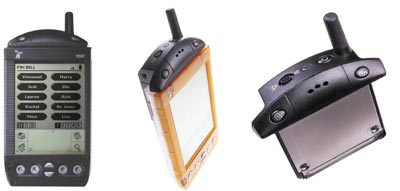 It
all started back in June 2000, when Jeff Hawkins, co-founder of Palm and
Handspring,
held a keynote address during PC EXPO in which he outlined the future of
smartphones. According to Hawkins, a smartphone needs great voice calling,
integrated PIM, messaging, and a good browsing experience to be successful.
It
all started back in June 2000, when Jeff Hawkins, co-founder of Palm and
Handspring,
held a keynote address during PC EXPO in which he outlined the future of
smartphones. According to Hawkins, a smartphone needs great voice calling,
integrated PIM, messaging, and a good browsing experience to be successful.
A couple of months later, in September 2000, Handspring
announced the
VisorPhone. Straight from the product description: "Transform your Visor handheld into a powerful communications
tool with VisorPhone. Not only is it a powerful dual-band world phone, it's also
a wireless modem. So you can make phone calls, surf the web, check email, chat
online and more�wirelessly. And with all the cool and useful programs already
built into your Visor handheld, you'll get information, communication and
integration�all in one highly portable, easy to use package." Sounds familiar?
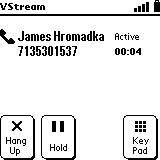 We
previewed the
Visorphone in October, and it
started shipping
in mid-December. "VisorPhone will bring a whole new voice communications and
computing experience to current and future Visor customers and we believe it
will truly change the way people communicate with each other," said Ed Colligan,
then senior vice president of sales and marketing for Handspring and now Palm's
President.
We
previewed the
Visorphone in October, and it
started shipping
in mid-December. "VisorPhone will bring a whole new voice communications and
computing experience to current and future Visor customers and we believe it
will truly change the way people communicate with each other," said Ed Colligan,
then senior vice president of sales and marketing for Handspring and now Palm's
President.
We reviewed
the Visorphone in early 2001. "With the Handspring VisorPhone, one can 1)
dial numbers directly from their address book, 2) use it as a GSM cellular
phone, 3) send messages to others using SMS, and 4) dial into an ISP and browse
the Internet. What more could you want?" reviewer James Hromadka asked.
Well
for one, the Visor and Visorphone combination was quite a bulky combination, and
the less than blazing 14.4kbps downloads made browsing quite slow. But at its
time, it rocked! Elements from the VisorPhone's hardware and software design are still with us
today, such as the ring silencer switch and parts of the the call application.
The VisorPhone initially cost $499 without a contract, and $299 with the
purchase of a service plan. Towards the end of its life-cycle it was just $99
or free with activation. A
CDMA version of the
VisorPhone was also made available by Sprint. We were quite surprised to
discover that Palm's website still has plenty of
information on the
VisorPhone.
The Treo Surfaces
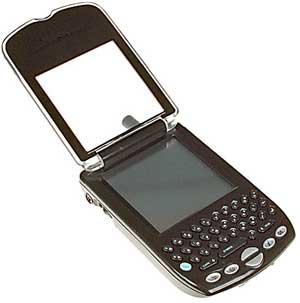 In
April of 2001, Handspring's CEO Donna Dubinsky
announced that
Handspring will offer PDA's with integrated wireless access sometime within
their next fiscal year, and a couple of months later, in August of 2001, we
discovered FCC
filings outlining what would become Handspring's upcoming wireless handheld
- the Handspring Treo. Two models were found, the Treo k180 and g180.
In
April of 2001, Handspring's CEO Donna Dubinsky
announced that
Handspring will offer PDA's with integrated wireless access sometime within
their next fiscal year, and a couple of months later, in August of 2001, we
discovered FCC
filings outlining what would become Handspring's upcoming wireless handheld
- the Handspring Treo. Two models were found, the Treo k180 and g180.
"The Treo models integrate a GSM cell/data phone into the hood of a Visor;
however, these units will likely be the start a separate family of handhelds and
will not be branded as Visor Treo. Why do we assume this? There is no
Springboard slot! Neither the preliminary manuals nor the images indicate that
these units can use Springboard modules - or contains any other expansion
capability (except for the obligatory hotsync port). Rather than using Grafitti
as input method, Treo k180 (k as in keyboard) uses a mini QWERTY keyboard
similar to Research In Motion's BlackBerry pager. The Treo g180 (g as in
Graffiti) uses a traditional handwriting area. "
In October 2001, Handspring
officially
announced the Treo family, describing the devices as "compact communicators,
combining a mobile phone, wireless email, messaging and web browsing, and a Palm
OS organizer in a small, lightweight device."
Treo 180
We first got our
hands on the Treo 180 during Comdex in November: "The first thing one
notices about the Treo is its size. The Treo feels just like a normal cell
phone. The flip lid of the Treo is aptly named, as it flips into place with only
the slightest of effort. The built-in keyboard on the Treo k180 works really
well, although I can tell that it will take awhile to wean myself from wanting
to use Graffiti."
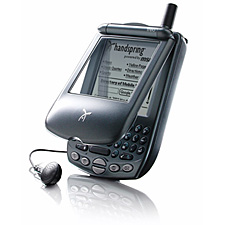 The
full review was
published in March: "The Treo 180 is a truly unique device in the Palm
world. There have been attempts at combining cell phones and PDAs before, but
those failed because of size and poor usability. Handspring has done an
excellent job of marrying the cell phone and PDA."
The
full review was
published in March: "The Treo 180 is a truly unique device in the Palm
world. There have been attempts at combining cell phones and PDAs before, but
those failed because of size and poor usability. Handspring has done an
excellent job of marrying the cell phone and PDA."
The Treo 180 did have one big drawback - the lack of a backlit keyboard made
it almost impossible to use in the dark.
The Treo 180 initially sold for $549 without a contract, and $399 with
the purchase of a service plan.
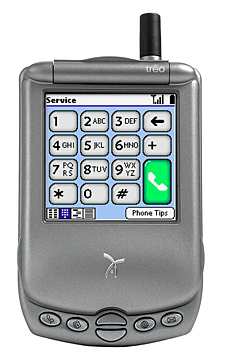 Treo
270
Treo
270
At the same time as the Treo 180 announcement, Handspring revealed that they
were working on a color display version for mid-2002. In May of 2002 they
announced the Treo
270 which improved upon the 180 with a color screen, a backlit keyboard, and
enhanced battery life.
We reviewed
the Treo 270 in June, and wrote that "while Handspring had made some
compromises with the screen of the Treo 270, the 270 was a solid handheld with a
good cell phone with an excellent interface. The backlit keyboard was worth the
price of admission alone for the Treo 270."
The Treo 270 initially sold for $699 without a contract, and $499 with the
purchase of a service plan.
Neither Treo 180 or Treo 270 initially came with GPRS enabled, but Handspring
offered a software upgrade later in the year. At first the upgrade was only
available for customers outside of the US, but we
offered a
quick work-around.
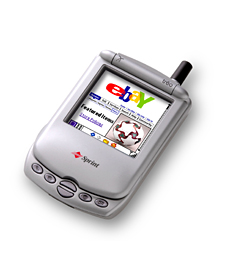 Treo
300
Treo
300
The Treo 180 and 270 were great communicators � but there were two things
noticeable absent at their introduction: high speed instantaneous Internet
access and limited rural coverage area (GSM networks at the time was just
starting to be built).
In July of 2002,
we learned about
plans for the Treo 300. The Treo 300 was expected to run on Sprint's
so-called third-generation (3G) CDMA network, which had theoretical top speed
for data of 150 kilobits per second.
Shortly thereafter FCC
posted documents
related to the Treo 300's approval process - and we got more information than we
bargained for. In addition to the standard test results and the product manual,
FCC posted a 28 page hardware specification of the Treo and plenty of product
images.
We reviewed
the Treo 300 in October, and concluded "it�s hard to imagine when you look
at the sleek small and compact Treo 300 that this device can access the Internet
twice as fast as the standard modems used on home computers. And since the
device uses Sprint�s extensive digital network for its connectivity, you can
enjoy a nationwide coverage area. The world of fast information at your
fingertips has arrived!"
The Treo 300 had some issues - mostly related with SMS functionality, since
Sprint's network at the time did not support true 2-way SMS.
The Treo 270 initially sold for $499 without a contract, and $249 with the
purchase of a service plan.
Treo 600
After the release of the Treo 300, all was quiet in Treo land until late May
2003. That's when the "next-generation" Treo was shown at the "D: All Things
Digital" conference. A member of our discussion board, who was relaying the word
of an attendee at the conference, claimed it to have a "Nice form factor... like
an oversize phone... no closing cover... retains the thumb keyboard... screen
very nice...".
Shortly thereafter Handspring demonstrated the Treo 600 at a Sprint PCS User
forum in Dallas, and several TreoCentral members were in attendance. Craigdts
provided the following sketch.
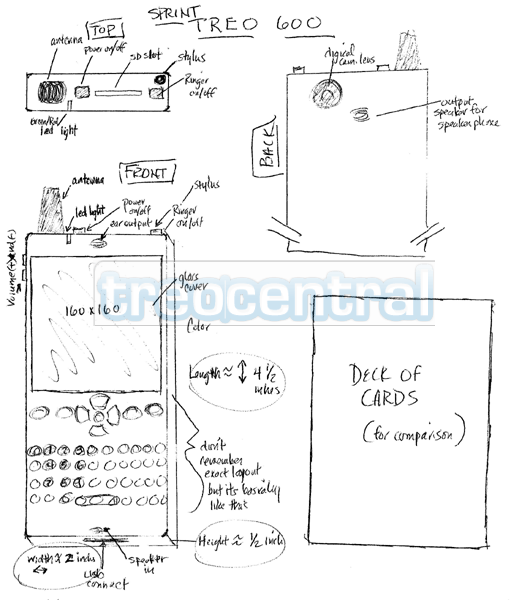
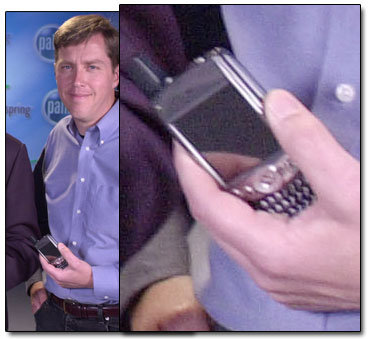 In
early June 2003 we got a
sneak peek of the
next Treo ourselves, due to a brilliantly positioned Treo 600 (in Jeff
Hawkin's hand) in a press image for Palm's acquisition of Handspring. Combined
with details learned from the Sprint User Forum, we developed a preliminary spec
sheet.
In
early June 2003 we got a
sneak peek of the
next Treo ourselves, due to a brilliantly positioned Treo 600 (in Jeff
Hawkin's hand) in a press image for Palm's acquisition of Handspring. Combined
with details learned from the Sprint User Forum, we developed a preliminary spec
sheet.
New Candy Bar style. No flip lid.
Smaller thumb board located at the bottom. The keys are domed, to make them
easier to hit. T
A D-pad and the usual 4 app buttons are located above the thumb board, in
the middle of the device..
No Jog Dial - in its place we find volume control.
Camera located on back of the unit (flash and pixel count unknown)
SD slot (SDIO compatible) located on the top.
TFT STN Screen (SuperTwist). Smaller brighter screen, offers better
visibility in sunlight. The resolution is estimated to be 160x160, similar to
today's Treo models.
ARM processor (Initial reports state 133 Mhz)
32MB
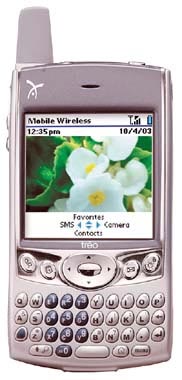 Handspring
officially
announced the Treo 600 on June 18th. The announcement confirmed our initial
reports, with only some minor changes to the spec sheet: The Treo 600 crams a
144 MHz ARM powered Palm OS 5 organizer, a GSM/GPRS or CDMA module a fully
integrated QWERTY keyboard, a five-way navigation pad, a 160x160 bright color
screen, a VGA (640x480) camera, 32 MB Ram, a SD/MMC slot, an improved battery
and audio system, and enhanced communication applications into a small
phone-like form factor. (4.41 inches x 2.26 inches x 0.87 (LxWxD), about 6 oz
depending on model).
Handspring
officially
announced the Treo 600 on June 18th. The announcement confirmed our initial
reports, with only some minor changes to the spec sheet: The Treo 600 crams a
144 MHz ARM powered Palm OS 5 organizer, a GSM/GPRS or CDMA module a fully
integrated QWERTY keyboard, a five-way navigation pad, a 160x160 bright color
screen, a VGA (640x480) camera, 32 MB Ram, a SD/MMC slot, an improved battery
and audio system, and enhanced communication applications into a small
phone-like form factor. (4.41 inches x 2.26 inches x 0.87 (LxWxD), about 6 oz
depending on model).
In addition the impressive hardware, the software had been updated to take
advantage of the new 5-way navigation pad.
In July, FCC
approved both Treo the GSM and the CDMA version of the Treo 600, and offered
details on the radio technology used inside the devices.It would take another three months until the
Treo 600 started
shipping in October 2003.
In January 2004 we finally
reviewed the Treo
600, calling it a mature product, as compared to the previous models.
"Handspring addressed many problems with the old Treo�s, and improved their
overall software. They successfully made a proxy less browser, and wrote a very
excellent email app. The 5-way navigator is integral to the Treo 600 because it
makes it possible to use the device one handed, a feature that makes the Treo
600 different form it�s competition. But don�t be fooled, the Treo 600 still has
a touch screen for the applications that require it. Battery life is greatly
improved over older Treo�s; it finally gives an acceptable talk time!"
The Treo 600 initially sold for $599 without a contract, and $449 with the
purchase of a service plan. It was phased out by Palm in September 2005.
Treo 650
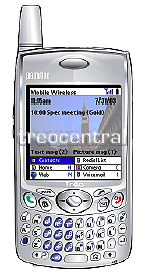 The
Treo 650 started out in rumor circles as the "Treo 610," and we
wrote an article
in April of 2004 with the information available at that time. Much of it turned
out to be wrong, but we hit the nail on the head with our
Treo Ace article
in June of 2004. "Over the last few months TreoCentral has built up an idea of
what one of the next generation Treos looks like ... We do not know the final
name for this next generation Treo - nobody seems to know ... As we could not
confirm either name, we will stick to the codename of this next generation Treo:
Ace."
The
Treo 650 started out in rumor circles as the "Treo 610," and we
wrote an article
in April of 2004 with the information available at that time. Much of it turned
out to be wrong, but we hit the nail on the head with our
Treo Ace article
in June of 2004. "Over the last few months TreoCentral has built up an idea of
what one of the next generation Treos looks like ... We do not know the final
name for this next generation Treo - nobody seems to know ... As we could not
confirm either name, we will stick to the codename of this next generation Treo:
Ace."
The article explained how the Treo Ace was substantial revision to the Treo
line. According to one source, "the cool factor is about the same between Ace
and the 600 as it was between the 600 and the 300. If anyone remembers their
first experience with the 600, seeing and holding the Treo Ace gives the same
gasp impression that you got when you first held the 600."
The Treo Ace would feature technology we longed for - a 320x320 screen,
Bluetooth, and dedicated send/end buttons.
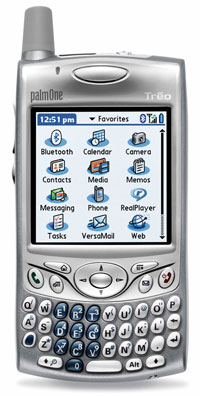 Several
months later, in October 2004 palmOne
officially
announced the Treo 650.
Several
months later, in October 2004 palmOne
officially
announced the Treo 650.
The Treo 650 was an evolutionary upgrade to the Treo 600. palmOne made slight
external changes to the form of the device, as they hoped to continue to
capitalize on the success of the Treo 600 platform. However, inside the Treo had
been rebuilt from the ground up. The most
notable new features were an improved 312 Mhz Intel PXA270 processor, a new
320x320 High resolution TFT screen, built in Bluetooth, non-volatile flash
memory, a removable battery, and a new connector.
Software wise the Treo 650 used Palm OS Garnet, 5.4 and featured improvements in the home
view, PIM integration, camera software, Blazer, communications software, and
various
bundled applications.
We wrote about our initial impressions of the Treo 600 in "Hands
on with the Treo 650", and a bunch our our initial questions were answered
in our Direct
from palmOne article.
Immediately
following its
release the Treo 650 was plagued with reports about its limited memory,
specially from Treo 600 users that were upgrading and found less available space
than on their older device. palmOne
responded by offering a free 128MB SD Card,
and eventually released a software update that resolved most of the memory
concerns.
The Treo 600 initially sold for $599 without a contract, and $449 with the
purchase of a service plan.
Treo 700w
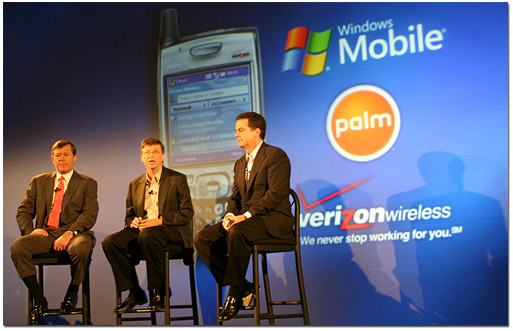 Which
leads us to the news of the week, the Treo 700w. Back in September we attended
the Palm,
Microsoft, and Verizon announcement, during which the Window's Mobile Treo
was first announced. Very little specific information about the new Windows
Mobile powered product was unveiled at this time, instead the conference focused
on the collaboration between the companies, and the new growth opportunity for
Palm.
Which
leads us to the news of the week, the Treo 700w. Back in September we attended
the Palm,
Microsoft, and Verizon announcement, during which the Window's Mobile Treo
was first announced. Very little specific information about the new Windows
Mobile powered product was unveiled at this time, instead the conference focused
on the collaboration between the companies, and the new growth opportunity for
Palm.
The new Treo smartphone is powered by Windows Mobile 5.0 and is the first 3G
enabled Treo. The smartphone will be a Verizon exclusive for the first half of
2005.
The Treo 700w is expected to be officially announced during CES this week.
TreoCentral's Michael Ducker and Marcus Adolfsson are heading to Vegas today,
and will be there all week. It will be a busy week.
Copyright 1999-2016 TreoCentral. All rights reserved :
Terms of Use : Privacy Policy
TREO and TreoCentral are trademarks or registered trademarks of palm, Inc. in the United States and other countries;
the TreoCentral mark and domain name are used under license from palm, Inc.
The views expressed on this website are solely those of the proprietor, or
contributors to the site, and do not necessarily reflect the views of palm, Inc.
Read Merciful by Casey Adolfsson
 It
all started back in June 2000, when Jeff Hawkins, co-founder of Palm and
Handspring,
held a keynote address during PC EXPO in which he outlined the future of
smartphones. According to Hawkins, a smartphone needs great voice calling,
integrated PIM, messaging, and a good browsing experience to be successful.
It
all started back in June 2000, when Jeff Hawkins, co-founder of Palm and
Handspring,
held a keynote address during PC EXPO in which he outlined the future of
smartphones. According to Hawkins, a smartphone needs great voice calling,
integrated PIM, messaging, and a good browsing experience to be successful. We
We
 In
April of 2001, Handspring's CEO Donna Dubinsky
In
April of 2001, Handspring's CEO Donna Dubinsky
 The
The
 Treo
270
Treo
270 Treo
300
Treo
300

 Handspring
Handspring
 The
Treo 650 started out in rumor circles as the "Treo 610," and we
The
Treo 650 started out in rumor circles as the "Treo 610," and we

 Which
leads us to the news of the week, the Treo 700w. Back in September we attended
the
Which
leads us to the news of the week, the Treo 700w. Back in September we attended
the